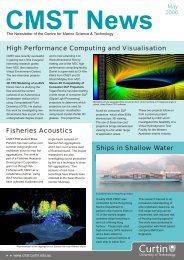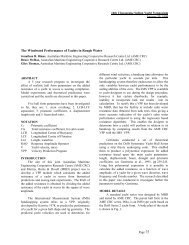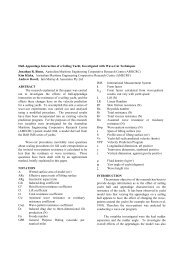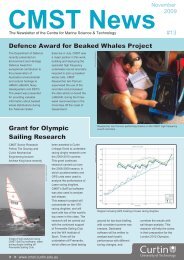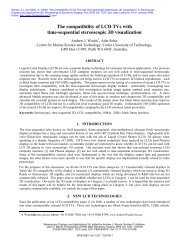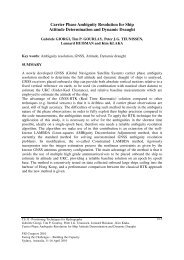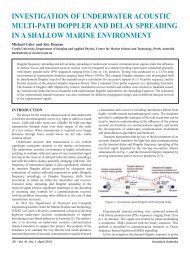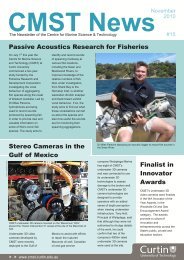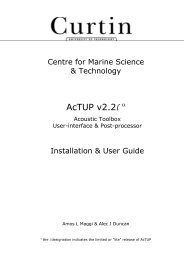Curtin CMST newsletter4d.cdr:CorelDRAW - Centre for Marine ...
Curtin CMST newsletter4d.cdr:CorelDRAW - Centre for Marine ...
Curtin CMST newsletter4d.cdr:CorelDRAW - Centre for Marine ...
You also want an ePaper? Increase the reach of your titles
YUMPU automatically turns print PDFs into web optimized ePapers that Google loves.
UNIVERSITY OF TECHNOLOGY<br />
September 2003<br />
THE NEWSLETTER OF THE CENTRE FOR MARINE SCIENCE & TECHNOLOGY<br />
Welcome to the <strong>CMST</strong> Newsletter.<br />
I hope that you will find the in<strong>for</strong>mation about our<br />
research and consultancy programs of interest.<br />
Andrew Woods, Director <strong>CMST</strong>.<br />
Seeing in Depth at Depth<br />
Earlier this year <strong>CMST</strong><br />
completed development of a<br />
pair of underwater<br />
stereoscopic video cameras <strong>for</strong><br />
Canadian company Welaptega<br />
<strong>Marine</strong> Ltd. The compact<br />
design (10cm diameter x<br />
24cm) and a new depth rating<br />
of 4000m mean that the<br />
cameras are very versatile.<br />
Soon after delivery, the<br />
cameras were used <strong>for</strong> ROV<br />
intervention by Shell / Todd in<br />
New Zealand, Sonsub UK in<br />
the Central North Sea, and BP<br />
UK / Subsea7 at a field northwest<br />
of Scotland. ROV<br />
operators really felt that the<br />
system was the answer to<br />
increasingly difficult and<br />
complex manipulator tasks.<br />
Professor Alexander<br />
Gavrilov<br />
Alexander (Sasha) Gavrilov<br />
commenced with <strong>CMST</strong> as<br />
Professor of <strong>Marine</strong> Acoustics<br />
in January this year. Sasha has<br />
an extensive background in<br />
theoretical and experimental<br />
ocean and arctic acoustics<br />
including low frequency sound<br />
propagation, bottom-interacting<br />
acoustics, acoustic tomography<br />
of ocean environments and sea<br />
floor sediments, ice scattering,<br />
acoustic thermometry, signal<br />
processing, and design of<br />
acoustic receiving arrays.<br />
Sasha has held a number of<br />
senior positions, most recently<br />
as Senior Scientist with the PP<br />
The response to the cameras<br />
has been so good we are<br />
currently negotiating the<br />
manufacture of another batch<br />
of systems.<br />
A.Woods cmst.curtin.edu.au<br />
(08) 9266 7920<br />
<strong>Marine</strong> Acoustics and Hydrodynamics Skills<br />
Shirshov Institute of Oceanology<br />
in Moscow, and has played<br />
principal roles in international<br />
programs including joint US-<br />
Russian initiatives in acoustic<br />
thermometry of the Arctic<br />
Ocean.<br />
A.Gavrilov cmst.curtin.edu.au<br />
(08) 9266 4696<br />
www.cmst.curtin.edu.au<br />
Coastal Success<br />
Coastal research is set <strong>for</strong> a<br />
large boost following the<br />
success in gaining funding <strong>for</strong><br />
a research program in Coastal<br />
The new compact stereoscopic<br />
video cameras (front and right) with<br />
other <strong>CMST</strong> stereoscopic cameras.<br />
Dr Tim Gourlay<br />
Dr Tim Gourlay joined <strong>CMST</strong><br />
as Hydrodynamics Research<br />
Fellow in December 2002.<br />
Tim's background is in<br />
mathematics and<br />
hydrodynamics and his main<br />
research and consulting<br />
activities are in seakeeping<br />
Water Habitat Mapping. The<br />
project started on 1st July and<br />
is part of the Brisbane-based<br />
Cooperative Research <strong>Centre</strong><br />
<strong>for</strong> Coastal Zone, Estuary and<br />
Waterway Management. The<br />
program has a total budget of<br />
nearly $10M.<br />
<strong>CMST</strong>'s Emeritus Professor<br />
John Penrose leads the new<br />
project and Dr Rob McCauley<br />
is managing one of the four<br />
sub-projects, Shallow Water<br />
Assessment Technologies.<br />
The project team has just taken<br />
delivery of a state-of-the-art<br />
shallow water acoustic swath<br />
mapping system which will be<br />
used <strong>for</strong> habitat mapping in<br />
locations including WA's<br />
Cockburn Sound and<br />
Recherche Archipelago.<br />
Project partners include UWA,<br />
DSTO, Geoscience Australia,<br />
Fugro Survey,<br />
and Reson.<br />
J.Penrose cmst.curtin.edu.au<br />
(08) 9266 7380<br />
and resistance of ships,<br />
underkeel clearance, yacht<br />
technology, and fluid<br />
dynamics.<br />
Between international sailing<br />
adventures, Tim has worked<br />
on a diversity of projects<br />
including dynamic vessel<br />
stability in waves, bores<br />
produced by high-speed<br />
vessels in channels, deckdiving<br />
of catamaran ferries,<br />
and reducing cavitation on hull<br />
appendages.<br />
Tim previously worked as a<br />
lecturer <strong>for</strong> two years with the<br />
Australian Maritime College in<br />
Launceston.<br />
T.Gourlay cmst.curtin.edu.au<br />
(08) 9266 3573
Underwater Sound Vessel Motions<br />
<strong>CMST</strong> has had several marine<br />
acoustics field programs over<br />
the past months.<br />
Air gun signals from seismic<br />
surveys operating in coastal<br />
waters between Dongara and<br />
Kalbarri were captured using<br />
the <strong>CMST</strong> sea noise recorders.<br />
These were analysed to<br />
determine their transmission in<br />
Western Australian coastal<br />
waters. Interestingly, in the<br />
shallow inshore water, the<br />
waterborne component of the<br />
air gun signals dropped away<br />
quickly leaving only sedimentborne<br />
low-frequency energy.<br />
Several more deployments of<br />
the <strong>CMST</strong> sea noise recorders<br />
were carried out in the Perth<br />
Canyon.<br />
A grid of three<br />
recorders was deployed in<br />
~450m of water on the Canyon<br />
edge from February to June<br />
2003. Many blue whale signals<br />
were acquired with some<br />
records capturing up to 14<br />
animals calling simultaneously.<br />
Work on the acoustic tracking<br />
of whales is progressing<br />
despite complications. These<br />
include multiple whale calls,<br />
Improved ROV Piloting<br />
Remotely operated vehicles<br />
(ROVs) are commonly used to<br />
carry out underwater survey,<br />
inspection, maintenance, and<br />
repair tasks. This usage is<br />
increasing in offshore oil and<br />
gas exploration and production<br />
as operations move into<br />
deeper waters out of reach of<br />
direct human intervention.<br />
Similarly, the use of ROVs<br />
by the world's armed<br />
<strong>for</strong>ces is also increasing,<br />
particularly <strong>for</strong> mine<br />
location and disposal.<br />
Research work being<br />
conducted by PhD<br />
candidate Peter Henley is<br />
aimed at increasing the<br />
operational effectiveness<br />
of ROVs by improving the<br />
For further in<strong>for</strong>mation contact:<br />
vessel and air gun signal noise<br />
(from a seismic survey being<br />
conducted over 400 km away),<br />
and a depth disparity in the<br />
hydrophones. Analysis<br />
suggests that the whales<br />
approach the Canyon from the<br />
south in a broad band, roughly<br />
bounded by the coast and the<br />
500 m contour. They then<br />
appear to focus over the<br />
Canyon (where the<br />
hydrophones were) be<strong>for</strong>e<br />
fanning out again to the north.<br />
We are yet to determine<br />
whether the blue whales were<br />
attracted to our subsea<br />
equipment or that we had<br />
<strong>for</strong>tuitously selected the best<br />
location <strong>for</strong> them.<br />
<strong>CMST</strong> also added to its<br />
growing list of recordings of<br />
industrial noise with the<br />
acquisition of acoustic signals<br />
from an underwater wellhead<br />
cutting operation using downhole,<br />
jet-grit blasting. As<br />
expected, it was a noisy event.<br />
Modelling of the cutting noise<br />
propagation is currently<br />
underway.<br />
R.McCauley cmst.curtin.edu.au<br />
(08) 9266 7460<br />
situational awareness of the<br />
pilots and their ability to<br />
navigate ROVs. Recent work<br />
has included the development<br />
of a virtual reality model of a<br />
Triton work class ROV which<br />
includes a detailed<br />
mathematical model of the<br />
ROV's umbilical.<br />
P.Henley cmst.curtin.edu.au<br />
(08) 9266 3555<br />
<strong>Centre</strong> <strong>for</strong> <strong>Marine</strong> Science and Technology<br />
GPO Box U1987, Perth WA 6845, AUSTRALIA<br />
Phone: +61 8 9266 7380 Fax: +61 8 9266 4799<br />
Email: Director cmst.curtin.edu.au Web: www.cmst.curtin.edu.au<br />
In April, ICON Engineering<br />
contracted <strong>CMST</strong> to supply a<br />
motions monitoring system <strong>for</strong><br />
the float-over installation of the<br />
topsides to the West Patricia<br />
WP-PA jacket <strong>for</strong> Murphy<br />
Sarawak Oil in Malaysia. The<br />
600 tonne plat<strong>for</strong>m was<br />
cantilevered off the bow of the<br />
transport vessel on a 6m deep<br />
truss with four hydraulic rams<br />
providing an additional 3.5m of<br />
lift during the installation.<br />
<strong>CMST</strong> developed software to<br />
ICON's specifications that,<br />
together with <strong>CMST</strong>'s TSS<br />
335B motion sensor, provided<br />
the operators with real-time<br />
motions data <strong>for</strong> the barge and<br />
the plat<strong>for</strong>m's stab cones<br />
during final approach and<br />
installation.<br />
<strong>CMST</strong>’s TSS 335B<br />
motion sensor<br />
Plat<strong>for</strong>m installation using <strong>CMST</strong> motions<br />
measurement equipment.<br />
Image courtesy of ICON Engineering.<br />
<strong>CMST</strong> regularly conducts fullscale<br />
trials of various vessel<br />
types using the TSS 335B<br />
motion sensor and other<br />
hardware to characterise<br />
seakeeping per<strong>for</strong>mance.<br />
<strong>CMST</strong> also provides related<br />
services including trials data<br />
analysis, interpretation and<br />
numercial modelling. <strong>CMST</strong>’s<br />
suite of equipment is also<br />
available <strong>for</strong> use in other<br />
motion compensation<br />
applications.<br />
T.Gourlay cmst.curtin.edu.au<br />
(08) 9266 3573<br />
Vessel Stabilisation<br />
<strong>CMST</strong> postgraduate student,<br />
Colin Ayres, won funding to<br />
present his paper on gyrostabilisation<br />
of roll in small<br />
vessels at the 28th IMTA-<br />
Interferry Conference in<br />
Rotterdam, Holland, 22-25<br />
September 2003.<br />
Upcoming <strong>CMST</strong> Seminars<br />
<strong>CMST</strong> holds regular seminars on marine science & technology<br />
topics - all welcome. <strong>CMST</strong> seminars are held at <strong>Curtin</strong> University,<br />
Physical Sciences Building 301, Room 147 and start at 12 noon.<br />
Bring your lunch - everybody else does.<br />
-<br />
ROLL MOTION OF YACHTS AT ANCHOR<br />
Tuesday 2 Sep Kim Klaka, <strong>CMST</strong><br />
-<br />
KRILL IN THE PERTH CANYON<br />
Tuesday 16 Sep Chris van Etten, <strong>CMST</strong><br />
-<br />
BLUE WHALES IN THE PERTH CANYON<br />
Tuesday 23 Sep Rob McCauley, <strong>CMST</strong><br />
-<br />
ACOUSTIC SIGNAL PROCESSING USING WAVELETS<br />
Wednesday 8 Oct Professor Jo Ward, Dean of Science, <strong>Curtin</strong><br />
-<br />
SQUAT OF A SHIP IN SHALLOW WATER<br />
Tuesday 14 Oct Tim Gourlay, <strong>CMST</strong><br />
-<br />
COGNITIVE WORK ANALYSIS AND ROV PILOTING INTERFACE<br />
DESIGN<br />
Tuesday 21 Oct Peter Henley, <strong>CMST</strong><br />
-<br />
FIELD USE OF STEREOSCOPIC VIDEO CAMERAS<br />
Tuesday 11 Nov Andrew Woods, <strong>CMST</strong><br />
-<br />
If you would like to receive email updates regarding <strong>CMST</strong><br />
seminars, simply send an email to <br />
to join our mailing list.



